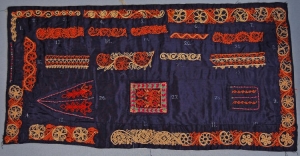The term for ‘Bethlehem embroidery’ in general is shughl talhami. If it is worked with a silk cord couching, then it is known as tahriri (or rasheq [not to be confused with Egyptian rashq] if crudely copied by others). When a gold or silver cord is used, instead of a silk version, then it is known as qasab.
Source: KAWAR, Widad and Gillian VOGELSANG-EASTWOOD (2016): 'Palestinian embroidery and clothing,' in: Gillian Vogelsang-Eastwood (ed.), Encyclopedia of Embroidery from the Arab World, London: Bloomsbury Academic, pp. 354-396.
British Museum online catalogue (retrieved 17th June 2016).
GVE

